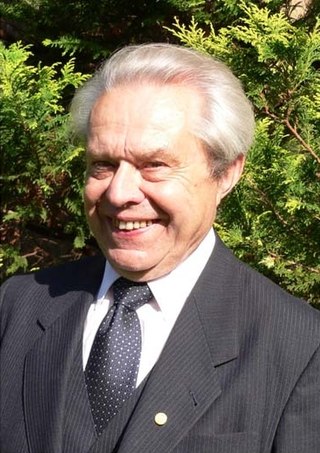
The American Chemical Society (ACS) is a scientific society based in the United States that supports scientific inquiry in the field of chemistry. Founded in 1876 at New York University, the ACS currently has more than 155,000 members at all degree levels and in all fields of chemistry, chemical engineering, and related fields. It is one of the world's largest scientific societies by membership. The ACS is a 501(c)(3) non-profit organization and holds a congressional charter under Title 36 of the United States Code. Its headquarters are located in Washington, D.C., and it has a large concentration of staff in Columbus, Ohio.

Ferdinand Frédéric Henri Moissan was a French chemist and pharmacist who won the 1906 Nobel Prize in Chemistry for his work in isolating fluorine from its compounds. Moissan was one of the original members of the International Atomic Weights Committee.

Pentafluoroethyl iodide is a suggested component of a fire-extinguishing composition. It is a very dense gas.

Tungsten oxytetrafluoride is an inorganic compound with the formula WOF4. It is a colorless diamagnetic solid. The compound is one of many oxides of tungsten. It is usually encountered as product of the partial hydrolysis of tungsten hexafluoride.
Otto Ruff was a German chemist.
The Electrochemical Society is a learned society based in the United States that supports scientific inquiry in the field of electrochemistry solid-state science and related technology. The Society membership comprises more than 8,000 scientists and engineers in over 85 countries at all degree levels and in all fields of electrochemistry, solid-state science and related technologies. Additional support is provided by institutional members including corporations and laboratories.

Fluorine is a chemical element; it has symbol F and atomic number 9. It is the lightest halogen and exists at standard conditions as pale yellow diatomic gas. Fluorine is extremely reactive as it reacts with all other elements except for the light inert gases. It is highly toxic.

Francine Marie Jeanne Houben is a Dutch architect. She graduated with cum laude honours from the Delft University of Technology. She is the founding partner and creative director of Mecanoo architecten, based in Delft, The Netherlands.
ISoFT is the abbreviation for the International Symposium on Fluorous Technologies. This symposium series was founded to discuss recent advances, including commercial applications, of technologies related to fluorous chemistry.
William Taylor Miller was an American professor of organic chemistry at Cornell University. His experimental research included investigations into the mechanism of addition of halogens, especially fluorine, to hydrocarbons. His work focused primarily on the physical and chemical properties of fluorocarbons and chlorofluorocarbons, and the synthesis of novel electrophilic reagents.
G. K. Surya Prakash is a Distinguished Professor of Chemistry, Chemical Engineering and Materials Science and holder of the George A. and Judith A. Olah Nobel Laureate Chair in Hydrocarbon Chemistry at the Department of Chemistry at the University of Southern California. He serves as the Director of the Loker Hydrocarbon Research Institute, where he maintains his prominent research lab. He also served as the Chairman of the Chemistry Department for four years between 2017 and 2021. He received a B.Sc. (Hons) from Bangalore University in 1972, a M.Sc. from IIT Madras in 1974 and a Ph.D. from University of Southern California in 1978 under the direction of George Olah, where he worked on characterizing stable carbocations in superacids. He also sits on several editorial boards of major scientific journals.

Fluorine is a relatively new element in human applications. In ancient times, only minor uses of fluorine-containing minerals existed. The industrial use of fluorite, fluorine's source mineral, was first described by early scientist Georgius Agricola in the 16th century, in the context of smelting. The name "fluorite" derives from Agricola's invented Latin terminology. In the late 18th century, hydrofluoric acid was discovered. By the early 19th century, it was recognized that fluorine was a bound element within compounds, similar to chlorine. Fluorite was determined to be calcium fluoride.

Karl Otto Christe is an inorganic chemist. He is the best reference in respectful handling of a huge number of extremely reactive components and his extensive experience in fluorine chemistry earned him the title of 'The Fluorine God'. His research covers fluorine chemistry of nitrogen and halogens and the synthesis of new energetic materials.

Georg Michael Hanack was a professor of chemistry at the University of Tübingen in Germany.
Giuseppe Resnati is an Italian chemist with interests in supramolecular chemistry and fluorine chemistry. He has a particular focus on self-assembly processes driven by halogen bonds, chalcogen bonds, and pnictogen bonds. His results on the attractive non-covalent interactions wherein atoms act as electrophiles thanks to the anisotropic distribution of the electron density typical for bonded atoms, prompted a systematic rationalization and categorization of many different weak bonds formed by many elements of the p and d blocks of the periodic table.
Véronique Gouverneur is the Waynflete Professor of Chemistry at Magdalen College at the University of Oxford in the United Kingdom. Prior to the Waynflete professorship, she held a tutorial fellowship at Merton College, Oxford. Her research on fluorine chemistry has received many professional and scholarly awards.
The European Symposium on Fluorine Chemistry (ESFC) is a triennial academic conference on Fluorine chemistry founded in 1965. The conference is held in Europe, but traditionally it brings together the fluorine community from all over the world. The scientific programme of the Symposium covers all the areas of fluorine chemistry relevant to fundamental and applied research.
Huang Weiyuan was a Chinese organic chemist and an academician of the Chinese Academy of Sciences. He served as President of the Shanghai Institute of Organic Chemistry and President of the Chinese Chemical Society.

Lothar Kolditz is a German chemist and former politician. He was president of the National Front of the German Democratic Republic.









